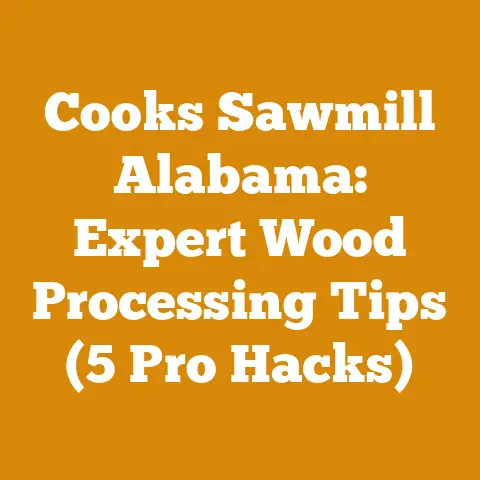Borax for Powderpost Beetles (5 Proven Wood Treatment Tips)
Why did the powderpost beetle cross the road? To get to the other wood!
Alright, alright, I know, not my best work.
But when we’re talking about powderpost beetles, humor is one way to cope with the devastation they can cause.
Dealing with these wood-munching menaces is a serious business, and that’s where borax comes in.
Borax, a naturally occurring mineral, can be a powerful ally in the fight against powderpost beetles.
I’ve spent years working with wood, from felling trees in the Pacific Northwest to processing firewood in the Appalachian Mountains.
I’ve seen firsthand the damage these tiny terrors can inflict.
Over the years, I’ve experimented with various wood treatment methods, and borax-based solutions have consistently proven to be effective and relatively safe.
Why Track Project Metrics for Wood Treatment?
Before diving into the tips, let’s address why tracking project metrics is crucial.
Imagine you’re treating a stack of lumber with borax.
Without tracking, you’re essentially flying blind.
Are you using the correct concentration of borax solution?
Are you applying enough solution to penetrate the wood?
Are you seeing a reduction in beetle activity over time?
Tracking metrics answers these questions. It allows you to:
- Optimize your treatment process: Identify what works best for your specific wood type and beetle infestation level.
- Reduce waste: Avoid over-application of borax, saving you money and minimizing environmental impact.
- Improve efficiency: Streamline your workflow for faster and more effective treatment.
- Verify effectiveness: Ensure your efforts are actually eradicating the beetles.
- Make informed decisions: Choose the best treatment strategies based on data, not guesswork.
5 Proven Wood Treatment Tips Using Borax
Here are five proven wood treatment tips using borax, along with the relevant metrics you should be tracking:
1. Accurate Borax Solution Mixing
What it is: The process of correctly mixing borax powder with water to create the appropriate concentration for wood treatment.
Why it’s important: The effectiveness of borax treatment hinges on the correct concentration.
Too weak, and it won’t kill the beetles.
Too strong, and it can leave a visible residue or potentially affect the wood’s finish.
How to interpret it: The recommended concentration typically ranges from 5% to 10% borax by weight.
This means 5-10 grams of borax per 100 ml of water.
I usually aim for around 7%, finding it to be a good balance between effectiveness and safety.
How it relates to other metrics: Improper mixing directly affects the Treatment Effectiveness Rate (see Tip #5).
If the solution is too weak, you’ll see a lower success rate.
Tracking Metric: Borax Concentration (BC)
- Definition: The percentage of borax by weight in the water solution.
- Measurement: Use a kitchen scale or measuring spoons to accurately measure the borax powder.
Use a measuring cup or graduated cylinder for the water.
Calculate the percentage using the formula: (Weight of Borax / (Weight of Borax + Weight of Water)) * 100. - Target Range: 5% – 10%
- Example: 70 grams of borax dissolved in 930 grams of water results in a BC of approximately 7%.
Personal Story: I once treated a batch of walnut lumber with a borax solution I thought was properly mixed.
Turns out, I hadn’t fully dissolved the borax powder.
Weeks later, I noticed beetle activity had returned!
Lesson learned: always double-check the mixture and ensure complete dissolution.
Actionable Insight: Always use warm or hot water to dissolve borax powder more easily.
Stir thoroughly until the solution is completely clear.
Label your mixed solution with the date and concentration.
2. Precise Application Techniques
What it is: The method used to apply the borax solution to the wood, ensuring adequate penetration and coverage.
Why it’s important: Even with the perfect concentration, if the solution doesn’t reach the beetles, it’s useless.
Proper application ensures the borax penetrates the wood and targets the larvae within.
How to interpret it: There are several application methods: spraying, brushing, soaking, and pressure injection.
Each has its advantages and disadvantages.
For surface infestations, spraying or brushing might suffice.
For deeper infestations, soaking or pressure injection is necessary.
How it relates to other metrics: Application technique directly affects the Wood Penetration Depth (see below) and ultimately the Treatment Effectiveness Rate.
Tracking Metric: Wood Penetration Depth (WPD)
- Definition: The depth to which the borax solution penetrates the wood.
- Measurement: After applying the solution, use a moisture meter to measure moisture content at different depths within the wood.
Elevated moisture content indicates the solution has penetrated.
Alternatively, you can use a boron test kit to chemically confirm the presence of borax at different depths. - Target Range: Aim for penetration to at least 1/2 inch, or deeper if the infestation is severe.
- Example: After spraying a board, you measure a moisture content of 15% at the surface and 12% at 1/4 inch depth.
This indicates shallow penetration.
Switching to a soaking method might be necessary.
Personal Story: I once tried to treat a log cabin with a simple garden sprayer.
It looked like I was doing a good job, but the beetles kept coming back.
I realized the solution wasn’t penetrating deep enough into the thick timbers.
I eventually invested in a pressure injection system, which made a huge difference.
Actionable Insight: Consider the wood’s density and the severity of the infestation when choosing an application method.
For dense hardwoods, pressure injection is often the most effective.
For softer woods, soaking may suffice.
Always wear appropriate personal protective equipment (PPE) when handling borax solutions.
3. Optimal Drying Time Management
What it is: The process of allowing the treated wood to dry properly after borax application.
Why it’s important: Proper drying is crucial for two reasons: it allows the borax to crystallize within the wood fibers, creating a protective barrier, and it prevents the wood from warping or cracking.
How to interpret it: Drying time depends on factors like humidity, temperature, and wood thickness.
The goal is to allow the wood to dry slowly and evenly.
How it relates to other metrics: Improper drying can lead to reduced Borax Retention Rate (see below) and ultimately lower Treatment Effectiveness Rate.
Tracking Metric: Borax Retention Rate (BRR)
- Definition: The amount of borax retained in the wood after the drying process.
- Measurement: Weigh a sample of wood before treatment.
Then, weigh it again after treatment and drying.
The difference in weight represents the amount of borax absorbed.
Calculate the percentage of borax retained by dividing the weight of borax absorbed by the original weight of the wood, multiplied by 100. - Target Range: Aim for a retention rate of at least 80%.
- Example: A piece of wood weighs 1 kg before treatment.
After treatment and drying, it weighs 1.05 kg.
The borax absorbed is 0.05 kg.
The BRR is (0.05/1) * 100 = 5%.
This is a very simplified example; in reality, the weight difference will be smaller and requires precise scales.
Boron test kits can also assess borax concentration.
Personal Story: I once rushed the drying process by placing treated lumber in direct sunlight.
The wood dried too quickly, causing it to crack and warp.
I had to discard a significant portion of the batch.
Now, I always dry treated wood in a shaded, well-ventilated area.
Actionable Insight: Dry treated wood in a shaded, well-ventilated area.
Use fans to improve air circulation.
Monitor the moisture content of the wood regularly using a moisture meter.
Aim for a gradual reduction in moisture content to prevent warping or cracking.
4. Regular Inspection and Monitoring
What it is: The process of regularly inspecting treated wood for signs of continued beetle activity.
Why it’s important: Even with successful initial treatment, re-infestation can occur.
Regular monitoring allows you to detect and address any new activity promptly.
How to interpret it: Look for signs like new exit holes, frass (powdery waste), or live beetles.
How it relates to other metrics: Monitoring provides feedback on the Treatment Effectiveness Rate over time.
If you see renewed activity, it indicates the treatment wasn’t completely successful or that re-infestation has occurred.
Tracking Metric: Re-infestation Rate (RIR)
- Definition: The percentage of treated wood that shows signs of re-infestation within a specified timeframe (e.g., 6 months, 1 year).
- Measurement: Regularly inspect treated wood and count the number of pieces showing new beetle activity.
Divide that number by the total number of treated pieces and multiply by 100. - Target Range: Aim for a RIR of 0%.
Anything above 0% indicates a need for further treatment or preventative measures. - Example: You treat 100 pieces of lumber.
After 6 months, you find 5 pieces showing new beetle activity.
The RIR is (5/100) * 100 = 5%.
Personal Story: After treating my workshop with borax, I thought I was done.
But a few months later, I noticed some fresh frass under a workbench.
Turns out, I had missed a small area during the initial treatment.
Regular inspections caught the problem early, preventing a full-blown re-infestation.
Actionable Insight: Schedule regular inspections of treated wood.
Use a flashlight to examine hard-to-reach areas.
Keep a log of your inspections, noting any signs of beetle activity.
Consider using sticky traps to monitor for beetle presence.
5. Quantifying Treatment Effectiveness
What it is: Measuring the overall success of the borax treatment in eliminating powderpost beetles.
Why it’s important: This is the ultimate metric.
It tells you whether your efforts have been successful in eradicating the beetles and protecting your wood.
How to interpret it: A high effectiveness rate indicates a successful treatment.
A low effectiveness rate indicates the need for adjustments to your approach.
How it relates to other metrics: The Treatment Effectiveness Rate is influenced by all the other metrics we’ve discussed: Borax Concentration, Wood Penetration Depth, Borax Retention Rate, and Re-infestation Rate.
Tracking Metric: Treatment Effectiveness Rate (TER)
- Definition: The percentage of treated wood that shows no signs of beetle activity after a specified timeframe.
- Measurement: After a sufficient period (e.g., 6 months, 1 year), inspect all treated wood.
Count the number of pieces that show no signs of beetle activity.
Divide that number by the total number of treated pieces and multiply by 100. - Target Range: Aim for a TER of 95% or higher.
- Example: You treat 100 pieces of lumber.
After one year, 97 pieces show no signs of beetle activity.
The TER is (97/100) * 100 = 97%.
Personal Story: I once treated a large stack of oak firewood with borax.
After a year, I inspected the wood and found that about 10% of the pieces still showed signs of beetle activity.
I realized I hadn’t applied enough solution to the larger pieces.
I retreated those pieces with a more concentrated solution and a pressure injection system, and the problem was resolved.
Actionable Insight: Track the TER over time to assess the long-term effectiveness of your treatment.
If the TER is consistently low, re-evaluate your entire approach, including borax concentration, application technique, and drying process.
1. Wood Volume Yield (WVY)
- Definition: The percentage of usable wood obtained from a raw log or tree.
- Why it’s important: Maximizing wood yield reduces waste and increases profitability.
- Measurement: Measure the volume of the raw log and the volume of the usable lumber or firewood produced.
Calculate the WVY using the formula: (Usable Wood Volume / Raw Log Volume) * 100. - Example: A log with a volume of 10 cubic feet yields 6 cubic feet of usable lumber.
The WVY is (6/10) * 100 = 60%. - Actionable Insight: Optimize your cutting patterns to minimize waste.
Consider using different sawing techniques for different log sizes and species.
2. Drying Time (DT)
- Definition: The time required for wood to reach the desired moisture content.
- Why it’s important: Proper drying prevents warping, cracking, and fungal growth.
- Measurement: Use a moisture meter to monitor the moisture content of the wood over time.
Record the time it takes to reach the target moisture content. - Example: It takes 6 months for oak lumber to dry from 30% moisture content to 12% moisture content in a particular drying shed.
- Actionable Insight: Optimize your drying process by controlling temperature, humidity, and air circulation.
Use a dehumidifier to accelerate drying in humid climates.
3. Equipment Downtime (EDT)
- Definition: The amount of time equipment is out of service due to maintenance or repairs.
- Why it’s important: Minimizing downtime maximizes productivity and reduces costs.
- Measurement: Track the time each piece of equipment is out of service for repairs or maintenance.
Calculate the total downtime for each piece of equipment over a specified period. - Example: A chainsaw is out of service for 2 days due to a broken chain and carburetor issues.
- Actionable Insight: Implement a regular maintenance schedule for all equipment.
Train operators on proper equipment usage and maintenance procedures.
4. Fuel Efficiency (FE)
- Definition: The amount of fuel consumed per unit of wood processed.
- Why it’s important: Reducing fuel consumption lowers operating costs and minimizes environmental impact.
- Measurement: Track the amount of fuel consumed by your equipment (e.g., chainsaw, skidder, firewood processor) and the amount of wood processed.
Calculate the FE using the formula: (Fuel Consumed / Wood Processed). - Example: A chainsaw consumes 1 gallon of fuel to process 1 cord of firewood.
- Actionable Insight: Use fuel-efficient equipment.
Optimize your cutting techniques to minimize fuel consumption.
Properly maintain your equipment to ensure optimal fuel efficiency.
5. Labor Cost (LC)
- Definition: The total cost of labor associated with a wood processing project.
- Why it’s important: Controlling labor costs is essential for profitability.
- Measurement: Track the hours worked by each employee and their hourly wage.
Calculate the total labor cost for the project. - Example: Two employees work for 40 hours each at an hourly wage of $20.
The total labor cost is 2 * 40 * $20 = $1600. - Actionable Insight: Optimize your workflow to improve labor efficiency.
Invest in equipment that reduces labor requirements.
Train employees on efficient work practices.
6. Wood Waste (WW)
- Definition: The amount of wood that is discarded or unusable after processing.
- Why it’s important: Minimizing wood waste reduces costs and improves sustainability.
- Measurement: Measure the volume or weight of wood waste generated during the project.
Calculate the percentage of wood waste using the formula: (Wood Waste / Total Wood Processed) * 100. - Example: 1 cubic foot of wood waste is generated from processing 10 cubic feet of logs.
The wood waste percentage is (1/10) * 100 = 10%. - Actionable Insight: Optimize your cutting patterns to minimize waste.
Find uses for wood waste, such as firewood, mulch, or compost.
7. Moisture Content (MC)
- Definition: The percentage of water in wood.
- Why it’s important: Affects wood’s weight, strength, stability, and suitability for different uses (e.g., firewood, construction).
- Measurement: Use a moisture meter to measure the moisture content of the wood.
- Example: Firewood with a moisture content of 20% or less burns efficiently.
Green wood can have a moisture content of 50% or higher. - Actionable Insight: Properly dry wood to the desired moisture content for its intended use.
Store wood in a dry, well-ventilated area.
8. Firewood Splitting Efficiency (FSE)
- Definition: The number of pieces of firewood split per hour.
- Why it’s important: Improves productivity and reduces labor costs.
- Measurement: Track the number of pieces of firewood split and the time taken.
Calculate the FSE using the formula: (Number of Pieces Split / Time Taken in Hours). - Example: 100 pieces of firewood are split in 2 hours.
The FSE is 100 / 2 = 50 pieces per hour. - Actionable Insight: Use a firewood splitter to increase efficiency. Optimize your splitting technique.
9. Customer Satisfaction (CSAT)
- Definition: A measure of how satisfied customers are with your wood products or services.
- Why it’s important: Improves customer loyalty and generates repeat business.
- Measurement: Conduct customer surveys or collect feedback through online reviews.
Use a rating scale (e.g., 1-5 stars) to measure customer satisfaction. - Example: Customers rate your firewood delivery service an average of 4.5 out of 5 stars.
- Actionable Insight: Provide high-quality wood products and excellent customer service.
Address customer complaints promptly and professionally.
10. Chain Sharpening Frequency (CSF)
- Definition: How often a chainsaw chain needs sharpening during a project.
- Why it’s Important: Indicates chain condition, cutting efficiency, and potential for damage.
Frequent sharpening can point to issues with chain tension, lubrication, or encountering debris. - Measurement: Record the number of times the chain is sharpened per day or per volume of wood cut.
- Example: A chainsaw chain needs sharpening twice a day when cutting hardwood.
- Actionable Insight: Ensure proper chain tension and lubrication.
Avoid cutting dirty or debris-laden wood.
Use a high-quality chain and file.
Applying These Metrics to Future Projects
Now that you understand these key metrics, how can you apply them to improve your future wood processing or firewood preparation projects?
- Establish Baseline Measurements: Before starting a new project, take baseline measurements for each metric.
This will give you a starting point for comparison. - Set Goals: Set specific, measurable, achievable, relevant, and time-bound (SMART) goals for each metric.
For example, “Reduce wood waste by 10% in the next project.” - Track Progress: Regularly track your progress against your goals.
Use spreadsheets, project management software, or even a simple notebook to record your data. - Analyze Results: At the end of the project, analyze your results.
Identify what worked well and what didn’t. - Make Adjustments: Based on your analysis, make adjustments to your processes for future projects.
Example:
Let’s say you’re preparing firewood for the winter.
You track your Firewood Splitting Efficiency and find that you’re splitting only 30 pieces per hour.
You decide to invest in a hydraulic firewood splitter.
In your next project, you track your FSE again and find that it has increased to 80 pieces per hour.
This data clearly demonstrates the benefit of investing in new equipment.
Challenges Faced by Small-Scale Loggers and Firewood Suppliers
I understand that small-scale loggers and firewood suppliers often face unique challenges.
Access to sophisticated equipment and software may be limited.
Time and resources are often stretched thin.
However, even with limited resources, you can still track these metrics using simple tools and techniques.
- Use a notebook and pencil: Keep a simple log of your activities and measurements.
- Use free spreadsheet software: Programs like Google Sheets or OpenOffice Calc can be used to track and analyze data.
- Focus on the most important metrics: Prioritize the metrics that have the biggest impact on your profitability and efficiency.
- Don’t be afraid to experiment: Try different techniques and track the results to see what works best for you.
Conclusion
Dealing with powderpost beetles can be frustrating, but by using borax strategically and tracking your progress with these proven wood treatment tips, you can effectively protect your wood and ensure the success of your projects.
Remember, consistent monitoring and data-driven decision-making are key to achieving long-term results.
Beyond beetle control, embracing a data-driven approach to wood processing and firewood preparation, leveraging the metrics I’ve discussed, is essential for optimizing efficiency, reducing waste, and improving the quality of your final product.
By tracking these metrics and making adjustments based on the data, you can continuously improve your processes and achieve greater success in your wood-related endeavors.
So, grab your borax, your moisture meter, and your notebook, and get ready to take control of your wood processing projects!






